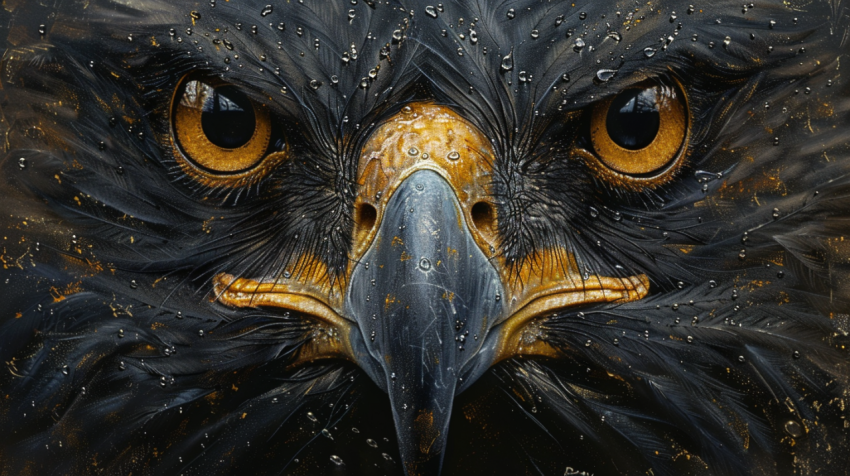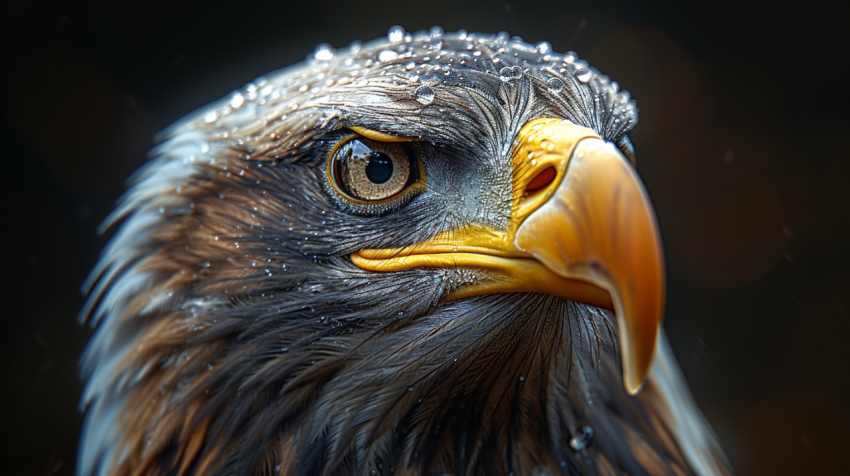











Majestic Eagles: Masters of the Sky
Eagles, with their impressive wingspans, sharp talons, and piercing gaze, are among the most powerful and awe-inspiring birds of prey on Earth. These majestic creatures have long captivated human imagination, symbolizing strength, freedom, courage, and nobility. In this comprehensive exploration, we will delve into the captivating world of eagles, examining their remarkable adaptations, diverse species, global distribution, hunting strategies, breeding behaviors, cultural significance, and the conservation challenges they face.
What Defines an Eagle?
Eagles belong to the family Accipitridae, which also includes hawks, kites, and harriers. While there is no single, universally accepted definition of what constitutes an "eagle," these birds are generally characterized by:
- Large Size: Eagles are among the largest birds of prey, with some species boasting wingspans exceeding 8 feet (2.4 meters).
- Powerful Build: They have a robust, muscular build, with a heavy, hooked beak and strong legs equipped with sharp talons.
- Exceptional Eyesight: Eagles possess extraordinary eyesight, estimated to be 4-8 times stronger than that of humans, allowing them to spot prey from great distances.
- Diurnal Predators: Eagles are diurnal, meaning they are active during the day.
- Carnivorous Diet: Eagles are apex predators, feeding primarily on a diet of fish, mammals, birds, and reptiles.
Diverse Eagle Species:
There are over 60 species of eagles found across the globe, exhibiting a remarkable diversity in size, appearance, and habitat preferences. Some of the most notable eagle species include:
- Bald Eagle (Haliaeetus leucocephalus): The national bird of the United States, the Bald Eagle is recognized for its white head and tail feathers, contrasting with its dark brown body. It is primarily found in North America, often near large bodies of water.
- Golden Eagle (Aquila chrysaetos): One of the most widespread and well-known eagle species, the Golden Eagle is found across the Northern Hemisphere. It is characterized by its dark brown plumage with golden feathers on the back of its head and neck.
- Harpy Eagle (Harpia harpyja): Found in the rainforests of Central and South America, the Harpy Eagle is one of the largest and most powerful eagles in the world, with incredibly strong talons capable of exerting immense pressure.
- Steller's Sea Eagle (Haliaeetus pelagicus): One of the largest eagle species, the Steller's Sea Eagle is native to coastal northeastern Asia and is known for its massive, yellow beak.
- Philippine Eagle (Pithecophaga jefferyi): Also known as the monkey-eating eagle, this critically endangered species is found only in the Philippines and is one of the largest and rarest eagles in the world.
- White-tailed Eagle (Haliaeetus albicilla): Found across Eurasia, the White-tailed Eagle is a large sea eagle with a distinctive white tail.
- Martial Eagle (Polemaetus bellicosus): Africa's largest eagle, the Martial Eagle is a powerful predator capable of taking down prey as large as small antelopes.
- Wedge-tailed Eagle (Aquila audax): Australia's largest bird of prey, the Wedge-tailed Eagle is known for its distinctive wedge-shaped tail.
Global Distribution and Habitats:
Eagles are found on every continent except Antarctica, inhabiting a wide range of environments, from mountains and forests to deserts and coastal regions.
- Adaptability: Eagles are highly adaptable birds and can be found in diverse habitats, including forests, mountains, grasslands, deserts, coastlines, and even near human settlements.
- Habitat Preferences: Different eagle species have specific habitat preferences. For example, sea eagles, like the Bald Eagle and White-tailed Eagle, are typically found near large bodies of water, while Golden Eagles often inhabit mountainous or open country.
- Territoriality: Eagles are highly territorial birds and will fiercely defend their territories, which can range in size from a few square miles to hundreds of square miles, depending on the species and the availability of prey.
Hunting Strategies and Diet:
Eagles are apex predators, sitting at the top of the food chain. Their exceptional eyesight, powerful talons, and aerial agility make them formidable hunters.
- Exceptional Eyesight: As mentioned, eagles have extraordinary eyesight. Their eyes are large, forward-facing, and equipped with a high density of photoreceptor cells, allowing them to spot prey from incredible distances. They can see details such as the movement of a rabbit in a field from miles away.
- Hunting Techniques: Eagles employ various hunting techniques, including:
- Soaring and Spotting: Eagles often soar high in the sky, using their keen eyesight to scan the ground below for prey.
- Perch Hunting: They may also perch on high vantage points, such as trees or cliffs, waiting for prey to come within range.
- Stooping: Once they spot prey, eagles can perform spectacular dives, called stoops, reaching speeds of up to 200 mph (320 km/h) before snatching their target with their powerful talons.
- Still Hunting: Waiting patiently for prey to come near.
- Piracy: Stealing food from other birds.
- Dietary Preferences: The diet of an eagle varies depending on the species and its habitat. Common prey items include:
- Fish: Sea eagles, like the Bald Eagle, are specialized fish eaters, using their talons to snatch fish from the water's surface.
- Mammals: Many eagle species prey on mammals, such as rabbits, hares, squirrels, marmots, and even larger animals like deer fawns or foxes, depending on the eagle species' size.
- Birds: Some eagles, like the Martial Eagle, are known to prey on other birds, including waterfowl, game birds, and even smaller raptors.
- Reptiles: Snakes, lizards, and other reptiles are also part of the diet of some eagle species.
- Carrion: While eagles prefer live prey, they will also scavenge on carrion (dead animals) when available.
Breeding and Nesting:
- Monogamy: Most eagle species are monogamous, forming long-term pair bonds that can last for many years, sometimes even for life.
- Courtship Displays: Eagles engage in elaborate aerial courtship displays, which may involve synchronized flying, vocalizations, and the locking of talons in mid-air.
- Nest Building (Eyries): Eagles build large nests, called eyries, typically in tall trees or on cliff ledges. These nests are often reused and added to year after year, sometimes growing to enormous sizes over time. They are typically made of sticks and lined with softer materials like grass, moss, and feathers.
- Egg Laying: The female eagle typically lays 1-3 eggs per clutch, depending on the species.
- Incubation: Both parents share incubation duties, although the female usually does the majority of the incubating. The incubation period varies by species but generally lasts between 35-45 days.
- Hatching and Fledging: Eagle chicks, called eaglets, are covered in downy feathers when they hatch. They are initially helpless and rely entirely on their parents for food and warmth. Both parents feed the eaglets, tearing off pieces of meat and offering them to the chicks. The eaglets grow rapidly and fledge (leave the nest) after about 10-13 weeks, depending on the species.
- Parental Care: Young eagles remain dependent on their parents for several weeks or even months after fledging, learning essential hunting and survival skills.
Cultural Significance:
Eagles have held significant cultural and symbolic meaning for humans throughout history:
- Symbols of Power and Strength: Due to their size, strength, and predatory prowess, eagles have often been associated with power, courage, and dominance.
- National Emblems: Many countries and nations have adopted eagles as their national emblems, including the United States (Bald Eagle), Mexico (Golden Eagle), Germany (Federal Eagle), and Poland (White-tailed Eagle).
- Spiritual and Religious Significance: In various cultures and religions, eagles have been seen as messengers of the gods, symbols of spiritual insight, or even divine beings themselves. For example, in Native American cultures, eagles are often considered sacred and are associated with the Great Spirit.
- Mythology and Folklore: Eagles feature prominently in mythology and folklore around the world. In Greek mythology, the god Zeus was often depicted with an eagle, and in Norse mythology, an eagle perched atop the world tree Yggdrasil.
Conservation Challenges:
While some eagle populations are stable, many species face significant conservation challenges:
- Habitat Loss and Degradation: The loss and fragmentation of eagle habitats due to deforestation, urbanization, agriculture, and other human activities pose a major threat to many eagle populations.
- Prey Depletion: Declines in prey populations due to habitat loss, overhunting, or other factors can negatively impact eagle populations.
- Poisoning: Eagles can be poisoned by consuming prey that has been contaminated with pesticides, lead, or other toxins.
- Collisions with Human Structures: Eagles are vulnerable to collisions with power lines, wind turbines, and vehicles.
- Persecution: In some areas, eagles have been persecuted by humans due to perceived threats to livestock or game animals.
- Climate Change: Climate change is predicted to have increasingly significant impacts on eagle populations by altering habitats, prey availability, and weather patterns.
- Illegal Wildlife Trade: Some eagle species are threatened by the illegal wildlife trade, with their parts being used for traditional medicine or other purposes.
Conservation Efforts:
Various conservation efforts are underway to protect eagle populations worldwide:
- Legal Protection: Many eagle species are protected by national and international laws, such as the Bald and Golden Eagle Protection Act in the United States and the Convention on International Trade in Endangered Species of Wild Fauna and Flora 1 (CITES).
- Habitat Restoration and Protection: Conservation organizations and government agencies are working to restore and protect eagle habitats, such as forests, wetlands, and grasslands.
- Captive Breeding Programs: Captive breeding programs have been established for some critically endangered eagle species, such as the Philippine Eagle, to help bolster their populations.
- Public Awareness and Education: Raising public awareness about the importance of eagle conservation and the threats they face is crucial for their long-term survival.
- Research and Monitoring: Ongoing research and monitoring programs help scientists better understand eagle ecology, population trends, and conservation needs.
Conclusion:
Eagles are truly magnificent birds that embody power, grace, and wildness. Their remarkable adaptations, diverse species, and vital ecological roles make them essential components of healthy ecosystems. By understanding the challenges they face and supporting conservation efforts, we can help ensure that these masters of the sky continue to soar for generations to come. Their continued presence in our world is a testament to the importance of preserving biodiversity and protecting the natural world.
Eagle, Bald Eagle, Golden Eagle, Eagle Species, Eagle Facts, Eagle Habitat, Eagle Diet, Eagle Hunting, Eagle Talons, Eagle Eyesight, Eagle Wingspan, Eagle Nest, Eagle Conservation, Eagle Symbolism, Eagle Meaning, Types of Eagles, Largest Eagle, Smallest Eagle, Eagle Lifespan, Eagle Predators, Eagle Adaptations, Eagle Flight, Eagle Pictures, Eagle Videos, Eagle Sounds, Eagle Distribution, Eagle Range, Are Eagles Endangered, How to Identify Eagles, Eagle vs Hawk.

